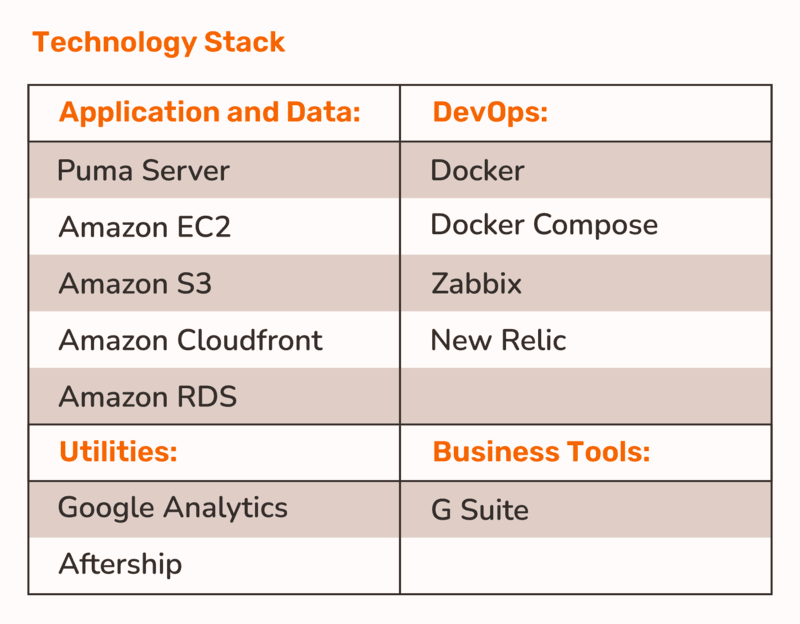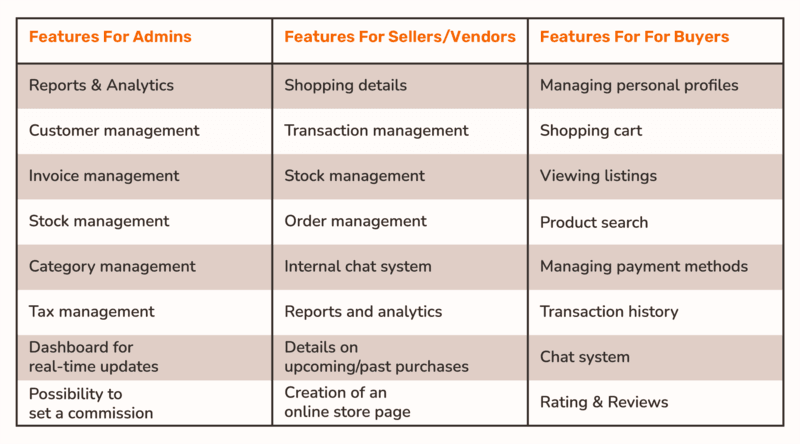Niche online marketplaces like Etsy are getting bigger and more popular day by day. Although just 10 years ago, e-commerce caused doubts and distrust among both buyers and vendors. However, everything has changed, and now a lot of people are shopping online. The number of sellers has also grown (it has increased by more than 10% in the last year).
The popularity of eCommerce marketplaces is obvious: after all, they're so easy to use, especially in a pandemic. And of particular interest are online stores like Etsy: those that specialize in just one thing.
Let's discuss the topic in more detail and figure out why niche startups are a good business idea. Maybe it's time to run something similar? Then the first step is to choose a specific market, which users need and even demand. And the second one is... well, keep reading, and you'll learn the answer! We'll explain to you how to build a website like Etsy.
Basics about Online Marketplaces
To build your own marketplace business, you should have a good understanding of the concept itself. So it doesn’t hurt to clarify all the details, just in case... if only to make sure we're on the same page.
A marketplace is a website or an application (or ideally both), which allows buyers and sellers (vendors) to find each other. The marketplace owners don’t produce anything, they work according to the model of the intermediary. Sometimes they may offer additional services such as communication with customers or assistance with delivery, but that’s optional.
So, building an Etsy-like website requires 3 basic components:
-
Platform as a meeting place for buyers and sellers;
-
Vendors or service providers;
-
Buyers, interested in the products/services of the above user group.
Marketplaces have rightly gained their popularity: in the end, they make life easier for both buyers and sellers. The first ones don't have to compare goods on dozens of sites or go to a shopping center anymore, everything they need is offered in one place. And sellers get an additional sales channel without extra investments.
It remains to add that along with online platforms offering products of all categories, there are niche marketplaces specializing in a certain market. And the most successful example of such resources is Etsy.
Perhaps now you’re wondering how to create a site like Etsy, aren’t you? Before we answer your question (and we will), we’d like to talk about Etsy itself, about its history and achievements… to help you get even more inspired.
What is Etsy?
Etsy has chosen to specialize in vintage crafts, art items, and handicrafts. Everything somehow related to creativity can be bought or sold on this resource.
By the way, the creators of Etsy were among the first to think of betting on niche products. And the idea proved successful and profitable.
Who can use Etsy?
-
Sellers:
-
professional creators of unique handmade products;
-
amateurs who want to make money from their hobby (handmade stuff);
-
people who own some vintage items and want to sell them.
-
-
Buyers:
-
collectors of rare items;
-
people looking for something special (for themselves or as a gift);
-
random shoppers who have visited Etsy and got interested in a particular handmade product.
-
Today there are a lot of sites similar to Etsy, and many of them are quite successful… however, Etsy remains one of the best, it's not less popular than such famous sites as Airbnb and Uber; here is the proof:
-
Etsy made over $440 million last year. Impressive, isn't it?
-
80+ million users are actively buying and selling handmade items on Etsy.
-
Etsy covers almost 235 countries around the world and is especially successful in the following ones:
-
The USA. At least 65% of Etsy traffic comes from the USA.
-
The UK. Etsy is very popular with small businesses in the United Kingdom.
-
-
Etsy is more mentioned on Instagram than Amazon (4x) and eBay (9x).
-
Etsy's Twitter audience is almost as big as Amazon's.
Some more cool stats
Surely, alternative sites to Etsy have their advantages too. But you know what makes our hero different from them (from selling platforms other than Etsy, we mean)? A high percentage of women among users and Etsy employees:
-
almost 90% of Etsy sellers are women;
-
more than 55% of the company employees are female;
-
next to 40% of women are working in technical professions.

By the by, what is the best way to monetize a website like Etsy? Let’s discuss it right away.
How Do Marketplaces Like Etsy Make Money?
-
Percentage of the cost of goods sold (commission). The most popular and fair monetization scheme is when the vendor shares the profits with the platform owner. Etsy is asking for a 5% commission on every sale.
-
Listing (Placement) fee. Wanna supplement your product list with one more item? You have to pay the so-called Listing fees first (about $0.20 when it comes to Etsy).
-
Freemium and various subscriptions. This is a very simple model to increase the profitability of your project. Its essence is that you allow the seller to place 100 (200, 500, whatever) products for free, and if it’s not enough and he wants more, he should pay an additional fee (access by subscription).
-
Let's say Etsy offers the Etsy Plus plan ($10 monthly).
-
-
Paid promotion. To stand out from other Etsy sellers, one needs to use the paid promotion feature: it allows the vendor to make his items top of the list.
-
Advertisements. Perhaps this is the most famous way to earn money on any website (although you have to use it carefully, too intrusive advertising annoys users, which is hardly good).
-
Alternative methods of monetization. Much depends on your imagination and resourcefulness. Etsy, for example, offers vendors to resort to its Etsy Payments, which are convenient and secure to deal with; also, they involve a rather low commission (about 3%, sometimes a little higher).
How to make a site like Etsy popular? You need to start by finding a lot of vendors willing to sell their goods with your help.
Let's take a look at what Etsy is doing to get sellers interested.
What attracts Etsy sellers?
-
Convenient interface and quick store setup. The vendor doesn’t need to have the skills to get down to business. A couple of minutes and the store is ready to go!
-
The target audience. Etsy offers access to a large audience of potential customers who are interested in handmade products and willing to make purchases.
-
Grounds for trust. Etsy cares about both buyers and sellers and has built a good reputation… which is, too, a good explanation of its popularity among vendors.
-
Community of like-minded people. All (or almost all) Etsy users are fans of handmade and vintage items. So Etsy provides not only a sales platform but also an opportunity to find like-minded people or even friends.
-
Educational pieces. And last but not least is the ability to get advice on how to improve the sales process from other vendors or from the materials Etsy posts on the resource.
Think about what you can learn from this experience to replicate the success of Etsy. Speaking of which… Let's see how it all began.
Etsy eCommerce Marketplace: How The Story Begins
The author of the project idea is a man in a creative profession, an artist and photographer named Rob Kalin. So his desire to focus on a resource offering handmade items is hardly surprising. But let's discuss the whole thing in order.
One day (in 2005) Rob Kalin realized that the world lacked a special online place to sell quality handmade products. And he decided it was time to create one... which he did with the help of his friends and business partners Chris Maguire and Chaim Skoppik.
All three guys were fond of creativity but didn't understand anything in IT. Their inexperience didn't stop them, though. That’s how a website called Etsy came to be (the name is related to the Italian expression "eh, si").
Initially, Etsy served as a freelance resource targeting creative people, but over time it had grown into something bigger; eventually, it managed to become a real global marketplace. However, it took Etsy no less than 2 years to be considered successful.
2 years... Is that a long time or a short one? Be that as it may, it was in 2007 that the millionth sale had been made on Etsy... which proved to everyone that Etsy was on the right track.
The growth of the audience and the boost of sales attracted the attention of venture capital funds. And Etsy received its first impressive investment (to be precise, it happened in early 2008).
Below, you can see the main milestones in the development of the Etsy project.

Etsy needed some time to capture the market, it didn't become successful overnight. And the reason isn't that the creators of Etsy did something wrong… it’s just in those years online marketplaces were new, no one trusted them… today it takes much less effort to run a profitable project and join the ranks of top-selling platforms like Etsy.
Technology Stack
Further in the article, we'll detail how to create a website like Etsy and explain to you what to take into account in the process. In the meantime, you should have a look at what technologies will help you implement your project in the best possible way.

The specified technology stack allows creating the functionality of a website like Etsy. And by the way, it's time to discuss it at length.
Core Features of Etsy-like marketplaces
You need to develop 3 user access panels:
-
Admin access. You should hire people to run and manage your platform to avoid problems (or to fix problems when they arise).
-
Seller access. A user who has registered as a vendor should be able to create a store page, add products to a listing, manage inventory, track payments, view analytics and statistics, chat with customers, and so on.
-
Buyer access. A user who resorts to Etsy to make purchases must have his own editable account, as well as access to product search and shopping cart. And, of course, you need to provide him with the online payment option.

And now let's figure out the basic principle of the platform’s operation: knowing how a marketplace like Etsy works, you can find your own development approach.
How does a marketplace like Etsy work?
Creating an Etsy store page is very simple and requires no special skills. In the end, the more difficult the registration process, the fewer sellers you’re likely to attract (and without them, the craft websites like Etsy won’t survive).
All the Etsy seller/vendor needs to do is click a couple of times to initiate the creation of a new store page, come up with its juicy name, and add a short description and products to sell (there's just no way around it!). Each item has to be supplemented with an image, an indication of what it is, what it is made of, etc. (the list of the must-have information is quite long).
We've already explained to you what the cost of maintaining a store consists of when discussing ways to monetize a website like Etsy. As you might remember, the seller pays for the product listing and the sale of each item. And bear in mind, a lot can only be published for 4 months, after which its placement must be extended (20 cents per another 4 months).
But most importantly, vendors don't need to register as private entrepreneurs since Etsy works with individuals as well.
The shopping process is even simpler and no different from what other eCommerce marketplaces offer:
-
Registration as a buyer and creation of your personal account (and make sure you have a bank card with a positive balance to perform payment);
-
Coming up with what you actually need (Etsy's product line consists of handmade goods and vintage items, as you remember);
-
Finding goods using the search engine and placing them in the cart (by using the Add to Cart button);
-
Going to the cart to process the order.
-
If the buyer chooses products from different stores, he'll have to deal with a few separate orders. He can put items in a single shopping cart but they'll be combined by orders from each store, as shown below.
-
How to Make a Website like Etsy Successful?
It’s not enough to create an online marketplace like Etsy. Also, you have to make sure it’s successful and profitable. Happily, we have a couple of tips to help you with this challenging task. Additionally, you might think about how to build a price comparison website, which has a few similarities in development process with Etsy.
Niche approach
As the annual Fortune 500 rankings show, the best strategy is to go from narrow to broad, so to say. So first you choose a narrow niche to specialize in. In the future, you can cover more markets if you wish.
We suggest that you target the area where you have real experience. This way, you’ll know a lot about your users' problems and would be able to solve them.
Great user experience
How to create an online marketplace like Etsy with a chance to become popular? The main condition is to provide both buyers and sellers with the best user experience. Your online platform should be personalized, reliable, and easy to use. That's all there is to it, actually!
Starting small
How much does it cost to create a website like Etsy? We cannot give an exact answer, because the price depends on many factors: contractors’ rate, the complexity of functionality, approach to development, and so on. Let's just say one thing: be prepared to pay a lot (and we mean it!).
What if you don't have enough budget? There are two options: find investors or start small.
-
Speaking of starting small, we refer to the mentioned niche approach, the MVP model (an Etsy-like marketplace with a minimum of basic features), and other ways to cut your budget.
Efficient search
The more efficient the search system, the more paying buyers you’ll have in the end. And we advise you to follow the example of Etsy in this regard.
The Etsy search engine is based on the analysis of titles and tags, as well as the prediction of item conversions. And in the near future, the search will use AI elements to examine product photos and descriptions to better understand what sells best.
Communication with users
The best online stores like Etsy get their way because they communicate with users and respond to their feedback. And you should do the same.
Marketing budget
And of course, don't forget about the promotion budget. After all, there can be a lot of websites like Etsy for art (or whatever) but only those whose owners are willing to invest in marketing will achieve success. Otherwise, how are buyers and sellers going to find out about the existence of your great resource?
Now it’s time to take a closer look at key steps to build an online marketplace like Etsy.
How to Create a Marketplace like Etsy
-
Clarification of the idea. You may think you know what you plan to get as a result. However, before you spring into action, you should clearly formulate your idea and determine the value of the future product.
-
Analysis and research, which consist of three stages:
-
Market research. You need to understand the market and IT trends.
-
Competitive analysis. It's time to analyze other online marketplaces like Etsy and identify their pros and cons.
-
Analysis of the target audience. What do users expect from your product? What problems are you solving and with what?
-
-
Building a business model, which includes, among other things, choosing the best way to monetize your project.
Surely, you can perform the above steps on your own if you feel confident you're able to pull this off. But if you do want to succeed and get the most out of it, order the Discovery Phase service. Experienced professionals will analyze the market, competitors (handmade websites like Etsy and other similar resources), and make a list of project requirements. All the data obtained will form the basis of your business plan... which means it's time to move on to the next development stages.
-
Prototyping. First, the experts you hired have to create a prototype designed to show you what screens/pages the application or site consists of. If you approve of what you see, the prototype can be turned into a real product.
-
If you order a Discovery Phase, prototyping would become part of it, which greatly simplifies and speeds up further development.
-
-
UX/UI design. UI/UX experts draw the screens (pages) of your resource and create each element of the digital interface.
-
Development. One of the most crucial and time-consuming project phases is coding and converting the website/application design into a working product. So it's very important that you hire experts with relevant experience.
-
By the way, we know how to build a site like Etsy, which we discuss just below (read on!). Therefore, we understand what challenges we may encounter during the development process and have experience in overcoming them.
-
-
QA activities. Never launch a product until it has been thoroughly tested, okay? QA engineers can help you with the task at hand. If they do know their business, they'll be able to check whether the site/application meets all the stated requirements.
-
Support and scaling. If you followed our advice and started small, you'll need to scale your resource in the future. But even if your budget allows you to do without saving, abandoning the project after it has been launched isn't a bright idea. Peer-to-peer marketplace businesses like Etsy require constant attention, financial investments, and care. This is the only way to success and prosperity.
Our Experience with Online Stores like Etsy
As we’ve already told you, our experts know how to build a website like Etsy, and these aren’t just bare words. We have similar projects in our portfolio. And one of them is a wholesale b2b marketplace.
Unfortunately, we cannot give a link to the resource in question because it's under NDA. But we'll provide you with a few inspiring details on our project.
It is a business-to-business mobile platform. Its mission is to serve as a link between Chinese and Indian suppliers and European and American retailers.
The resource is easy to use and has many cool features, among which are Siri integration, AR support, wishlists, notifications, and others.
And by the by, project clients include such big names as Adidas.
As you now understand, we’re quite capable of developing an Etsy marketplace from scratch (or rather an Etsy-like marketplace). Let's get down to business, shall we?



